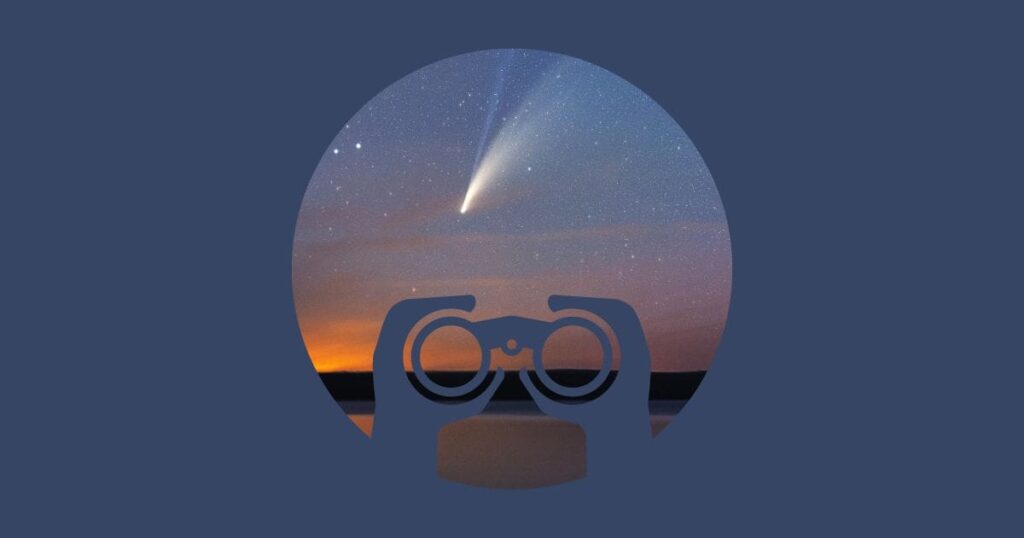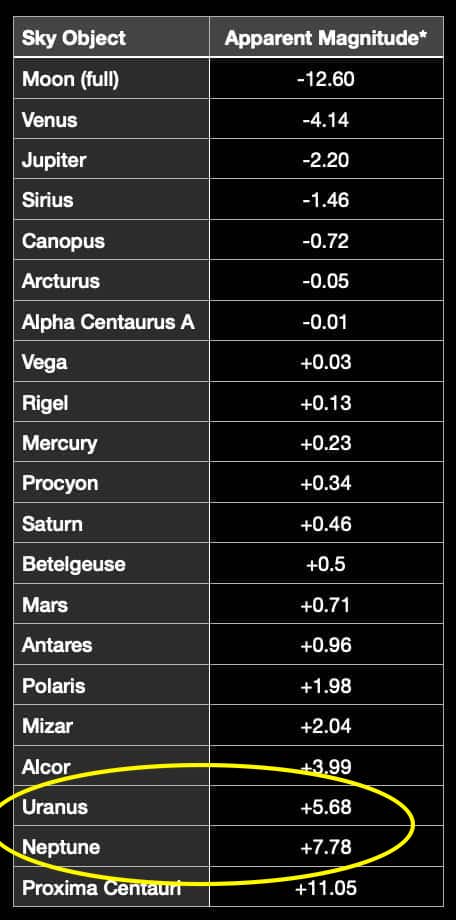Wondering whether binoculars are any good for astronomy. There are many reasons to use binoculars in stargazing. How good are binoculars for astronomy? Here are 13 reasons to invest in a pair if you’re a night sky watcher…

What can you see with astronomy binoculars? Let’s see. Comets. The Moon’s features in more detail. But read on for reasons why it’s worth using binoculars.
Want to find a perfect pair of binoculars for astronomy? See my guide on the best astronomy binoculars.
Using binoculars for astronomy
There are several ways to use binoculars for astronomy. I know from using them that for all of the ways I list below, you first need a way to steady them.
Place your elbows on a fence, on the roof of your vehicle, or on a table while holding the binoculars. I list other alternatives further below.
1. Accessory to telescope – an extra finderscope
It’s not a matter of binoculars vs telescope, but rather a case of binoculars adding to the experience of using that home telescope to help find stars and planets in the night sky.
With binoculars, you can get quickly acquainted with the night sky and the positioning of celestial bodies.
You’ll have an extra finderscope to find objects to target in the sky.
2. Above horizon viewing
Binoculars are the best for viewing planets rising and when just above the horizon. It can be difficult to position and use a telescope for this angle. Venus is a planet you’d view at this angle — above the horizon.
3. Viewing comets
Binoculars are perfect for observing bright comets like 21P, 38P, and 46P/Wirtanen that grace our skies from time to time and are spectacular sights. It can be tricky using a telescope, given the pace of comets.
4. Find outer planets
With binoculars, you can search out Uranus and Neptune with the help of finder charts. These planets are distant and you’ll have trouble seeing them with the naked eye.
Compared to the larger Jupiter or even Saturn with its rings, these outer planets don’t have stand-out features.
Neptune has a star magnitude of about 8 and Uranus 5, which are within the said limit of 9 for binocular viewing. You need to train your eye though.
Allow your eyes to adapt to the darkness, and to keep your eyes dark-adapted, avoid bright light. This means using a red flashlight to find your way and read charts.

5. Planet viewing and star hopping
Quality astronomy binoculars are useful for planet viewing, especially Jupiter with its moons and Saturn with its rings, and for viewing conjunctions of the planets.
Expect to see the reddish glow of Mars and the red giants of stars, Aldebaran, Betelgeuse, and Antares, through a good set of binoculars. Alpha Centauri appears yellowish and Beta Centauri blueish.
6. Lunar occultations
Small binoculars are ideal for observing lunar occultations (when the Moon passes in front) of a star of magnitude 4 or less (brighter).
7. Moon features
Binoculars are perfect for viewing features of the Moon — making out the large craters and maria (seas) and more.
8. Finding fainter stars
Binoculars are best for finding the fainter stars in star atlases and finder charts.
Binoculars can help you see up to 25x – 50x more stars than with your naked eyes –depending on the unit you choose.
Compared to a telescope, binoculars allow magnification for both eyes and so you double (enhance) the opportunity for your brain to scan and register the starlight of the night sky.
9. ‘Dimmed’ stars
A moonlit sky makes stars appear dimmer. Binoculars help with finding and viewing stars that appear dim due to the brightness and position of the Moon in the night sky.
10. Moons of Jupiter
The more powerful ones are useful for observing the moons of Jupiter as they move around the planet.
At present astronomers recognize 79 Jovian moons, so there are plenty to look for.
11. Great for kids
Binoculars can be more lightweight and compact than portable telescopes. They are also easy to use, require minimal setup, and are a great way to get children interested in astronomy.
12. Wider field of view
Binoculars have a wider field of view and this is a big plus for scanning the sky for targets and seeing patterns in the cosmos. You better appreciate how night sky objects are positioned in relation to each other.
13. Give you the correct perspective
You’ll see the night sky from the right side up. It can be confusing looking through the focuser of a telescope when using a sky chart or even after looking at the sky with your unaided eyes as standard telescopes show you the sky upside down.
How to set up binoculars for astronomy
I think everyone would or should know the basics of using a pair of binoculars and the gear itself (including the different types of prisms).
There are three things that can cause you a little bit of frustration with astronomy binoculars. One is focusing, two is image stability, and three is finding the target object.
1. Focusing the Binoculars
- Right lens – focus binoculars
Place a lens cover over the right front lens (or close that eye) and focus the binoculars by turning or adjusting the diopter (the eyepiece that turns). - Left lens – adjust the eyepiece
Switch to the left side. With the front left lens only covered (or left eye only shut), adjust that same eyepiece ring until the image is sharp. - Ready to go
Remove the lens covers or open your eyes and you are ready to go
2. Stabilizing the image
You’ll find better alternatives for comfort that are also portable in my article on holding binoculars steady.

